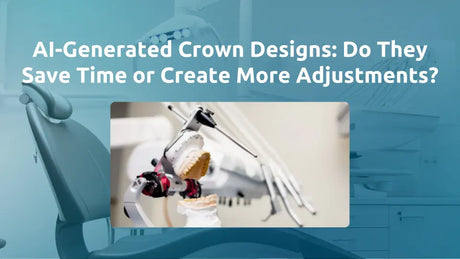For decades, orthodontics was seen as something mostly for kids and teens. Braces were a rite of passage for many adolescents, and once adulthood began, the assumption was that it was “too late” to correct misaligned teeth.
Today, that picture looks very different. Adult orthodontics is no longer rare, it’s quickly becoming part of mainstream dentistry. More adults are seeking treatment to improve not only their smiles but also their long-term oral health and function. With clear aligners, discreet appliances, and digital treatment planning, orthodontics is now more accessible, comfortable, and appealing to patients well into their 30s, 40s, and even beyond.
Why Adults Are Choosing Orthodontics

There are several reasons why adult orthodontics is growing:
Aesthetic demand. Adults increasingly want straighter teeth for professional and personal confidence. With options like clear aligners and ceramic brackets, orthodontics no longer carries the social stigma it once did.
Oral health benefits. Misaligned teeth are harder to clean, leading to a higher risk of periodontal disease and tooth wear. Correcting malocclusions helps preserve natural dentition.
Technological advances. Digital scanning, 3D imaging, and CAD/CAM orthodontic solutions make treatments faster, more precise, and more predictable.
Expanded patient awareness. Social media, cosmetic dentistry marketing, and general health consciousness have made adults more open to investing in their smiles.
How Treatment Differs for Adults
Treating adults requires a different approach than treating younger patients. Adults often present with more complex cases, including existing restorations, bone loss, or periodontal concerns. Treatment planning must consider these factors to avoid complications.
Adult patients may also prioritize shorter treatment times and aesthetics during treatment. This is why clear aligners, lingual braces, and low-profile brackets are popular options. Clinicians must balance these demands with biomechanical principles and patient compliance.
For labs and clinicians, adult orthodontics also means coordinating with other specialties. Implantologists, periodontists, and prosthodontists often work together with orthodontists to create comprehensive treatment plans for adults with missing teeth or complex occlusal issues.
The Role of Digital Orthodontics
Digital technology is one of the biggest drivers of adult orthodontics. Intraoral scanners replace uncomfortable impressions, and digital planning software allows orthodontists to show patients projected outcomes before treatment even begins.
CAD/CAM manufacturing and 3D printing give labs the ability to produce aligners, retainers, and appliances with remarkable accuracy. This precision reduces errors, speeds up production, and improves overall patient experience.
Using platforms like WholeDent’s orthodontic supplies collection practices can also standardize materials and streamline ordering, keeping treatments efficient and consistent across multiple cases.
Is It Really Becoming Mainstream?
The numbers suggest yes. Research shows that the percentage of adult orthodontic patients continues to rise steadily worldwide. In the U.S., adults now make up nearly one-third of all orthodontic patients, a major shift compared to past decades.
What was once considered unusual is now an accepted part of comprehensive dental care. For many patients, orthodontics is no longer about aesthetics alone but part of a larger oral health strategy.
Actionable Checklist for Practices
✅ Educate adult patients on the oral health benefits of orthodontics, not just aesthetics.
✅ Offer multiple appliance options (aligners, ceramic brackets, lingual systems) to fit patient preferences.
✅ Incorporate digital workflows for scanning, treatment planning, and appliance fabrication.
✅ Collaborate with labs and specialists when cases involve implants or advanced restorative needs.
✅ Stock reliable, standardized orthodontic components for consistent results.
Frequently Asked Questions
Is adult orthodontics more difficult than treating teens?
Often yes, because adults may have bone loss, restorations, or missing teeth. Treatment planning requires more customization.
Are results as effective in adults?
Yes. Tooth movement is possible at any age, though treatment may take slightly longer compared to adolescents.
Do adults prefer aligners over braces?
Many do, but aligners are not right for every case. Some complex movements may still require fixed appliances.
How long does treatment usually take for adults?
Most adult treatments last 12–24 months, depending on case complexity and patient compliance.
Conclusion
Orthodontics in adults is no longer a niche trend, it’s becoming mainstream. Patients now see it as an investment in both their smile and their oral health. With discreet appliances, digital workflows, and better collaboration between clinics and labs, orthodontic treatment for adults is more accessible than ever.
WholeDent supports this growing demand by providing clinics and labs with a wide range of orthodontic systems, appliances, and restorative materials. For practices looking to expand their adult orthodontic offerings, explore WholeDent’s collection is a strong first step.
By pairing these resources with proven technologies from GDT, dental teams can deliver predictable, esthetic, and long-lasting results for adult patients seeking orthodontic care.
References
-
Keim RG, Gottlieb EL, Vogels DS, Vogels PB. 2014 JCO Orthodontic Practice Study. J Clin Orthod. 2014;48(10):607-630. https://pubmed.ncbi.nlm.nih.gov/25416338/
-
Buschang PH, Shaw SG, Ross M, Crosby D, Campbell PM. Incidence of relapse and need for retreatment after orthodontic treatment. Am J Orthod Dentofacial Orthop. 2012;141(4):469–478. doi:10.1016/j.ajodo.2011.09.030
-
Papadimitriou A, Mousoulea S, Gkantidis N, Kloukos D. Clinical effectiveness of Invisalign® orthodontic treatment: a systematic review. Prog Orthod. 2018;19(1):37. doi:10.1186/s40510-018-0235-z













